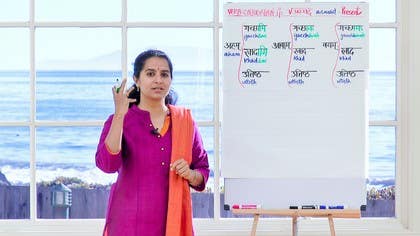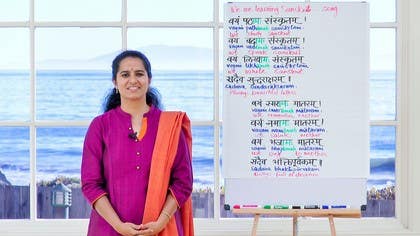Description
About This Video
Transcript
Read Full Transcript
Namaste dear friends, we've been working with verb conjugations, we associated actions with the verb forms and then we also saw what those verbs look like when you wrote them out. In the third person, the second person, formal, informal, but you know it's much more exciting when we can use the verbs on ourselves and say what I am doing. That's when the verbs really start sitting within our system. So we have already seen or we've heard how these verbs sound like when we did the demonstration with myself and Alana in the first person. The pronoun root of that is asmat, but that's just a detail here.
So we'll see what the first person verb is conjugated like in the present tense. So when one person or I am doing the action, it is aham and I go gachami, aham gachami. Say that, aham gachami. What I recommend is that every time you talk of yourself doing an action, do the action. Then you also add movement into the learning of that particular verb.
The tip in this form of the verb conjugation is to remember that it is me. So in English, you have the me to say I. So when you say I, you know that the verb has to end with a me. Or if you hear a verb ending with a me, you can be sure that it is I who is doing the verb. Whoever is talking, it's that person who is doing that particular verb, action.
So here we go, aham gachami, aham and that's what it looks like, aham gachami. I have also made the a in green because in most cases, the form in the first person single will get the a. But in some cases like when the verb is what am I doing, it will be aham kim karo me. So you see, it's karo me, it's not kara me. So there are different ways in which the different verbs conjugate.
But when you hear the me at the end of it, you can be sure that it is the person who is talking who is doing the action. So aham gachami. So if I am eating aham kadami, very good, so let's put it there, kadami, kadami. To help you practice the combination of the vowel with the consonants, the a, that a long vowel gets the extra stick beside the consonant. So the plus a, kadami, lovely.
Sometimes I find the challenge with some students is that if you're not paying attention 100%, you can tend to leave that stick out. In which case the pronunciation would be kadami and that doesn't make sense in Sanskrit. All right, so you need to put that line in to make sure that what you're saying or what you're wanting to say is well communicated. So it has to be kadami. And again, I'd like to just invite you to understand that the more you sound it.
So if you are used to saying kadami, gachami, likami, patami, automatically when you have to write it, the a, the vowel a will sound in your consciousness and you will put that line in. But if you're not used to sounding it, you can find yourself leaving it out just because it's not evident in your understanding of that word. All right, so practice sounding, really that's the key in Sanskrit. So kadami, I wake up or I stand up, uttish tami, lovely, uttish tami, there we are, uttish tami, great. So I go, aham gachami, say that and do it, aham, I eat, aham kadami, great, I go, aham kadami, lovely, I stand up, aham, uttish tami, fantastic.
Now you remember when it was two people, us, we two, you have to have the vam inside and it's a vam, the two of us. When the two of us are going now, it is gachavah, gachavah, say that, gachavah, think of another good friend of yours and you're going together. So aham gachavah, that's what it would look like, gachavah, yeah. Now if the two of us are eating, it would be aham kadavah, aham kadavah, a lot of actions happen in couples and that's why the dual case is so important in the Sanskrit language. Now that's the beauty of practicing the dual when you are having your meal with a friend, a very dear friend.
So in your mind, just practice this application of the verb. So just in your mind, just bring the Sanskrit to your four of your consciousness and say avam kadavah. You can even read the avam out. If you just said kadavah, kadavah, that would be enough to indicate that we two are doing something. The two of us stand up, uttish, lovely, uttish, ta, vah, my vah has touched the line but you need to just make sure that it has a gap there, alright, it's the vah, uttish, ta, vah, uttish, vah, very nice, got that.
So let's say that once, I'll say it and you repeat after me, avam kadchah, vah, very nice, avam, we eat, two of us eat, avam kadavah, very nice. The two of us stand up or wake up, avam, uttish, ta, vah, fantastic. So getting a taste of that, great. We move on to the plural now. So we've seen that with the plural, it becomes maha.
First of all, we get put in the yum yum and we know that it is the we yum, so vayam, alright, that's for we in Sanskrit. So vayam we go will be gachamaha, vayam gachamaha, lovely. We eat vayam kadamaha, say that, vayam kadamaha, great. We stand up, vayam, uttish, ta, maha, lovely, uttamam, uttish, ta, maha, that's really good, alright. So what we'll just do to revise is say the verb to go with I, the two of us and all of us.
Aham gachami, avam gachavaha, and vayam gachamaha, super, you want to close your eyes, I'll just sound it to you once, see if it can, you can remember that. So close your eyes, aham gachami, see yourself going, now see two of you going, avam gachavaha, and now see many of you going, vayam gachamaha, great. I'll just say the verbs, not even with the pronoun, means the same thing, close again, gachami gachavaha, gachamaha, when you're memorizing it, when you get accustomed to saying it fast, it somehow becomes easier to remember it. So we'll say together now once, gachami gachavaha, gachamaha, fantastic. Now I'm very excited because I'd like to do a little song with you in the next section and that will help you just remember this army form much better, when you are doing an action.
Alright, so see you soon then, namaste and have a great day.
Mother Tongue: Verbs
Comments
You need to be a subscriber to post a comment.
Please Log In or Create an Account to start your free trial.










